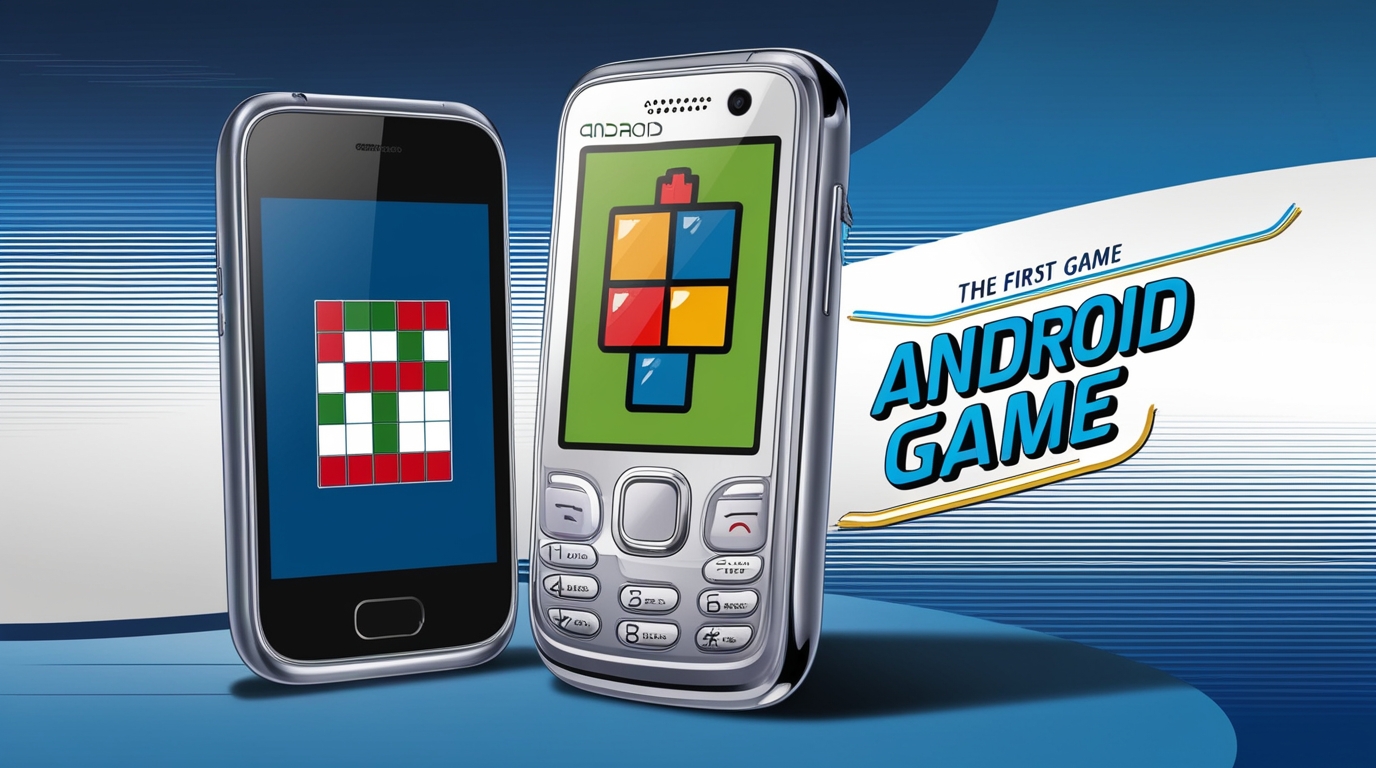Ever wondered what the very first Android game was? It’s a question that brings back nostalgia for the early days of smartphones when touchscreens were new, and apps were just starting to change the world. But here’s the twist — there wasn’t just one single “first” Android game. The history of Android gaming is a blend of creativity, experimentation, and rapid growth.
Early developers didn’t have fancy tools or massive studios; they had innovation and passion. So, let’s take a deep dive into how Android gaming began and explore the early titles that shaped the platform we love today.
Android’s Early Beginnings
To understand the first Android game, we need to rewind to 2008 — the year Android 1.0 was officially launched. This was when smartphones were still finding their footing. The very first Android phone, the HTC Dream (also known as the T-Mobile G1), came with simple apps and limited graphics power.
The Android Market (which later became Google Play Store) was launched around the same time, allowing developers to upload their apps and games. However, things were not as organized back then — records were incomplete, and many games went unnoticed.
The Dawn of Android Gaming
When the Android Market opened its virtual doors, a wave of experimental games appeared almost instantly. Most of these early titles were simple — think puzzles, memory games, and retro-inspired remakes. Developers were testing what Android could handle.
The operating system was new, hardware was limited, and 3D graphics were still a dream. Because of this, it’s impossible to point to one single “first” game. Instead, several early games competed for the title of being among the pioneers of Android gaming.
The Contenders for the First Android Game
Let’s explore the early games that made their mark. Some were developed by indie creators working out of small studios, while others were released by established names testing the Android ecosystem for the first time.
Pac-Man by Namco
If you owned an early Android phone, chances are you came across Pac-Man. While it wasn’t exclusive to Android, Namco quickly adapted this legendary arcade title for the platform.
It was among the first recognizable games to appear on Android devices. Pac-Man demonstrated how classic gaming could live on in a touchscreen world and set the stage for future retro revivals.
Snake ’97
Snake ’97 was a nostalgic recreation of the original Nokia snake game. It wasn’t flashy, but it brought a piece of mobile gaming history to Android. Released in the late 2000s, it became one of the earliest casual games available on the Android Market.
It appealed to users who missed the simplicity of pre-smartphone gaming and served as a comforting bridge between old and new technology.
Bonsai Blast
Here’s where things get interesting. Bonsai Blast, developed by Glu Mobile in 2008, is often cited as one of the first major Android-exclusive games. It was a vibrant, marble-shooting puzzle game that showed off Android’s touch capabilities and smooth performance.
Bonsai Blast stood out not just for its gameplay but also because it came pre-installed on some early Android phones, introducing millions to gaming on the platform. It proved that Android could deliver fun, polished experiences comparable to iPhone games of that era.
The Memory Game
Not every early Android game came from a big developer. “The Memory Game” was one of the first indie puzzle titles available in the Android Market. It featured a simple concept — match pairs of cards — yet it was surprisingly addictive.
Developers used these types of games to experiment with touch response, color handling, and screen refresh rates. It might seem basic today, but back then, it was part of Android’s foundation in casual gaming.
Replica Island
No discussion of early Android games is complete without Replica Island. Released in 2010 and developed by Chris Pruett, a former Google engineer, this side-scrolling platformer became a benchmark for what Android games could achieve. Replica Island was not just a game — it was a learning tool. Pruett made the game’s source code public so that developers could study its structure.
It was beautifully animated, technically sound, and most importantly, open-source. Even though it came two years after Android’s launch, it’s often seen as a turning point in Android gaming development.
Labyrinth by Illusion Labs
Labyrinth was another early hit, arriving around 2009. It used the phone’s accelerometer — a brand-new feature at the time — to simulate a real wooden maze game. Players tilted their phones to roll a ball through obstacles.
This simple mechanic made Labyrinth revolutionary, as it showcased Android’s ability to merge physical interaction with virtual gameplay. It was both fun and a technical demonstration of the smartphone’s potential.
Robo Defense
Released in 2009, Robo Defense was one of the first tower-defense games on Android and arguably the first to achieve massive popularity. It combined strategy, endless gameplay, and a smooth interface, all without needing high-end graphics.
Many gamers consider it the first Android game that truly felt like a full experience rather than a small experiment. Its success encouraged more developers to invest in Android gaming seriously.
Why It’s Hard to Name One “First” Game
Unlike consoles or PCs, where releases are tracked meticulously, early Android games often lacked proper documentation. The Android Market was new, and developers could upload apps freely without official approval processes. Many early titles disappeared before the Play Store evolved. Some games were localized versions that never reached global audiences.
Additionally, multiple developers released games simultaneously during the platform’s first months, making it impossible to declare a single “first” game.
Timeline of Early Android Games (2008–2010)
2008: Android Market launched, and early casual games like Bonsai Blast and Pac-Man ports appeared.
2009: Games like Labyrinth and Robo Defense showcased technical growth.
2010: Replica Island arrived, raising the bar for Android game design and inspiring new developers.
This three-year period was crucial in establishing Android as a legitimate gaming platform.
The Role of Developers in Early Android Gaming
What truly made Android gaming take off wasn’t the hardware — it was the developers. Indie programmers were the lifeblood of the platform. They experimented, took risks, and helped define what mobile gaming could become.
Studios like Glu Mobile and Namco brought their experience from other platforms, while independent developers contributed creativity and fresh ideas. Together, they created a foundation that future gaming giants would build upon.
Impact of Replica Island on Android Development
Replica Island deserves special recognition because of its open-source nature. Chris Pruett made the game’s entire codebase available for free, encouraging others to learn from it. This decision helped thousands of new Android developers understand how to create efficient, smooth, and enjoyable games.
It wasn’t just a game — it was a tutorial wrapped in entertainment. Replica Island showed that Android could compete with iOS in terms of performance and innovation.
How to Download Early Android Games
Curious to try some of these early Android classics? Here’s how you can do it safely and easily.
-
Search for the game title on the Play Store: Some classics like Bonsai Blast and Replica Island are still available in modern versions.
-
Use trusted APK websites: If the original game isn’t on the Play Store anymore, you can find it via reputable APK sites that host archived Android apps.
-
Check compatibility: Early games were designed for older versions of Android, so some may not work properly on modern devices.
-
Try emulators: You can use Android emulators on PC to experience these games in their original form.
-
Stay safe: Always download from reliable sources and avoid unofficial or modified versions.
Revisiting these early titles is like stepping into a time machine — simple graphics, nostalgic sounds, and pure fun without ads or microtransactions.
Evolution After 2010
After 2010, Android gaming exploded. Developers began using advanced engines like Unity and Unreal. 3D graphics became standard, and multiplayer options opened up. Games like Angry Birds, Temple Run, and Fruit Ninja defined the mobile era.
The foundation laid by early titles like Bonsai Blast and Replica Island helped create the environment where these blockbusters could thrive. The leap from simple puzzle games to full-scale adventures shows how far Android has come in just over a decade.
Conclusion
So, which was the first Android game invented? The honest answer: there wasn’t just one. The early years of Android gaming were a time of experimentation, creativity, and rapid innovation. Games like Bonsai Blast, Labyrinth, and Replica Island each played a vital role in shaping Android’s identity.
While we may never pinpoint a single “first” game, what truly matters is the pioneering spirit of those early developers who turned a brand-new operating system into a playground for millions.
FAQs
1. What year was the first Android game released?
The first wave of Android games appeared in 2008, the same year Android 1.0 launched.
2. Who developed Replica Island?
Replica Island was developed by Chris Pruett, an early Android engineer at Google.
3. Was Angry Birds one of the first Android games?
No, Angry Birds was released later in 2010, long after Android gaming had already begun.
4. What was the first popular Android game?
Bonsai Blast and Robo Defense were among the first widely popular Android titles.
5. Why is it hard to identify the first Android game?
Because the Android Market launched without strict records, many early titles were released simultaneously, and some were lost over time.


